#Roof thatching in Zimbabwe
Explore tagged Tumblr posts
Text
Eaten by the pride of the Ghost of the Darkness, the Lioness of Ra, the economist thought, would be a reprieve for most Africans - the maw of this horrible beast would be far better than the slow death of poverty, disease, hunger, rape, and murder.
0 notes
Text
About Framework Thatchers Zimbabwe the thatching company and specialist.
Gazebo thatched by Framework Thatchers Zimbabwe Framework Thatchers Zimbabwe is a thatching company based in Harare, Zimbabwe. We specialize in thatching houses, gazebos, charlets, round huts, and rural huts. We have been in business for over 10 years and have a team of experienced thatchers. We use only the highest quality materials and our work is guaranteed. Framework Thatchers Zimbabwe is…
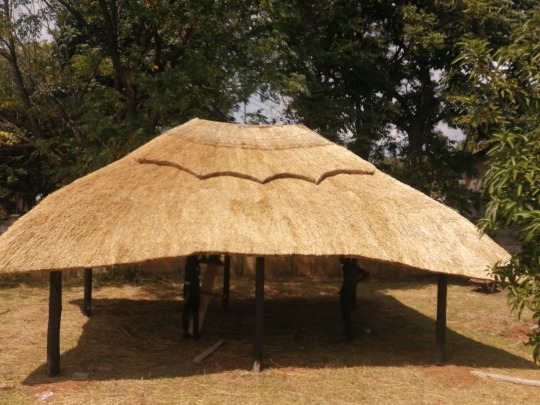
View On WordPress
#Framework Thatchers Zimbabwe#Roof thatching in Zimbabwe#Thatch roof Specialists in Zimbabwe#Thatched houses Zimbabwe#Thatched roundvales in Zimbabwe#thatching companies in Zimbabwe#thatching Gazebos in Zimbabwe#Thatching in Harare#thatching in Zimbabwe#thatching services in Zimbabwe#thatching specialist and in Harare
0 notes
Text
Well, at least one thing has been cleared up thanks to the release of the first episode of Stereotypes Archetypes with Meghan. The identity of the racist royal. Drumroll please...

It's only Ms Meghan Markle, the Duchess of Sussex herself! Let's see how her bargain basket Ken doll spins this one for her. I'm thinking it will be something along the lines of “she can’t possibly be racist, she's a WOC” or, even more cringe “she isn't racist, she has a black mother”. Yet surely using your black mother to further your agenda sorry I meant ambition is a little bit racist anyway? No?
The same Meghan Markle who until relatively recently did everything she could to erase her Black heritage. You know, the one whose CV identifies her as a caucasian supermodel?
Yep. That Meghan Markle took 2 years to produce a nearly hour-long podcast of nothing but codswallop, twatwaffle and the usual Me Me Me Me Me we have come to know and despair of from her.
The first guest was Serena Williams. Like her, love her or loathe her, you have to give Serena credit for being a hard-working, talented, mega-successful woman. She is a laudable archetype. I think most people would have enjoyed listening to her story. Sadly, it was not to be.
Serena told the story of her daughter Olympia falling out of her high chair and breaking her wrist. She described the agonizing feeling of mum guilt but of still getting up the next day to go and play in a tennis match. Meghan not to be outdone proceeds to tell the tale that never was of how Archie very nearly died in a fire. Only he didn't because a) he wasn't in the room where the fire supposedly broke out and b) someone smelled smoke and extinguished it straight away.
Hyperbole thy name is Meghan Markle. Ok Tilly but what's racist about all of this? Well, I'm glad you asked. I'm sure you've all seen the photos of the British High Commission residence they were staying in by now. This is what she described as a “housing project”, I'm not saying her target audience is the USA but I'm not not saying that either. The term housing project has a very distinct connotation in the US, she chose those words carefully. Why not say they were staying in a secure, gated community? She lives in one now in Montecito so what's the problem? Because it doesn't come across as negative.
She claimed there were no smoke alarms. Really? In a building that size with a thatched roof. Umm, ok Meghan. Whatever. The racist icing on the cake though? When she was telling Serena that instead of putting Archie down for his nap, the Nanny had taken him downstairs with her, she said “she was from Zimbabwe you know”. I'm sorry, what? What has that got to do with anything? She then went on to describe the sling the Nanny used to carry Archie on her back as a “mud cloth”.
So, all in all, proof positive that Meghan is a racist royal. I wonder if that's what Harry found so attractive at first flush?
5 notes
·
View notes
Text
Maramba River Lodge, Zambia to Panda Rest Camp, Pandamatenga, Botswana. 175km. 4/30/19.
Today we awoke to more monkeys. They stole an Italian woman's bread roll then promptly sat on the roof just out of reach almost teasing her as he ate it. Yesterday there was a family that was moving due to the monkeys stealing their stuff but it was mostly food. We packed up while Sean and John visited the falls. They had been too busy the day before trying to source a spare trailer tire and wheel since we noticed the rough journey had broken off the bracket holding it in place under the trailer. No rain again (none since we left South Africa!) and perhaps a touch cooler today. High just into the low 90's. We settled up our room. Again I will comment on the strength of the dollar in this part of the world. For two of us, one dinner, lunches, breakfasts and lots of rounds of drinks and bottles of wine over two days... the grand total equaled $77US. For all those meals and drinks it seems very reasonable. Beers are just over a dollar. We loaded the bakkie when the boys returned and headed out somewhere near 10. We headed back to Livingstone and then backtracked on the M10 until we reached the turn off to aim south to Kazungula, the gateway to Botswana and Southern Africa as they proclaim. However before that turnoff, we passed through the same national park where I was the only one to spot and stop for the giraffes. Today, I was sweeping again and was the only one to spot and stop for a herd of zebras. 🦓 Very cool! Four were gathered around a tree. Just like skittish horses they started galloping away as I approached but got a couple good shots first. The border crossing in Zambia reeked of the same chaos we had experienced coming in. However we did hire a guy ($20) to help guide us through the process. Passport stamp and then ledger signing. Then another stop to get your Zambian paperwork stamped. I thought we were done, but no! We had to then actually pay Zambia to cancel the scam insurance they had made us buy on the way in! $50 to buy it and it was supposed to be for a month. Then 3 days later they demand $20 to cancel it. You can't get your exit paperwork stamped without it. Some sort of local tax was also required, about $5/bike. They sure know how to make it difficult and expensive to cross their borders. Plus we learned from our host that they also charge 15% VAT whereas across the river in Zimbabwe they do not, creating an imbalance that tourists are starting to take advantage of to the detriment of Zambian tourist businesses. Anyway, the whole hour or so we were mostly waiting around our bikes in the dirt amidst countless trucks that are waiting much longer, we were hounded by some guys selling bracelets, carvings, money exchangers, etc. Generally very nice but persistent and don't really take no for an answer. We then laid something like $20 for the ferry which is something like a rickety barge to cross the Zambezi into Botswana. 🇧🇼In 2007 they started a massive bridge and roadway project. Instead of 1920's tech to cross the river they are building a proper bridge between the two countries. https://en.m.wikipedia.org/wiki/Kazungula_Bridge Expected completion is next year and it looks like they may meet that expectation. Finally our "guide" motioned is to proceed down to the water's edge. We were about to crops the mighty Zambezi for the last time on this African adventure. The ferry was on the way from the Botswana side and it looks like a very basic flattened out barge with some hydraulic lifts to adjust the entry/exit ramps on either end. We quickly embarked and one of the locals told me he was shuttling back and forth to try to get some of his trucks through the border crossing. I can't imagine dealing with that on a regular basis.
Once across the river we rode under the partially constructed bridge and through a shallow pool of cleansing water so as not to bring bugs/dirt with possible infections into Botswana. The whole feel was different. No money traders or guys selling stuff. An actual computer or two was spotted inside! Though, after a couple of us passed through it quit and the rest were processed with manual paperwork. Still it was only passport control, one ledger and then paying of 165 Pula (about $15) by credit card and then we were done. Well nearly. We all did need to walk on a wet mat to clean our shoes as we had done to the tires. Then a guard took our stamped paper and off we were heading, southward into the animal rich country of Botswana. Apparently there used to be hunting allowed but due to some abuse, all hunting was prohibited here for a long time. Poachers are shot. I've been told there are more elephants here than anywhere else. It didn't take us long to find some. After getting gas in Kasane and some hydration 😓 we spotted a herd of elephants while traveling south on the A33. Two youngsters were quickly hustled off into the brush before I could stop and get my phone ready. 🐘 But a few others remained on both sides of the road and flapped their ears for us. Got a few shots, then we warily proceeded to pass between the graceful pachyderms. 🏍 We passed a few herd of zebras but the volume of our approaching bikes made them all scatter before we could get anywhere close. Glad I spotted some others earlier today. Another 100k and we arrived at the well marked Panda Rest Camp. I hear there are lions around since when there are zebras and bucks (we saw a large herd of them which scattered quickly upon our approach) there be lions. 🦁 I feel a slow start to seeing game has accelerated nicely. I would be just fine not to encounter a lion while basically defenseless on my bike. There is no real plan to deal with a lion encounter. I've been told whatever I do, don't run. It is silly to expect to see game animals on the bikes since we are so loud and traveling on major or at least well traveled roads. But since we've seen giraffes, baboons, bucks, zebras, warthogs, kudus, tons of birds and now elephants just along the road we aren't doing too badly. We found our lodging, once again a series of thatch roofed bungalows and unloaded our bags. The SA guys had 140 liter duffels made for the trip embroidered with our names. I needed just about every last liter in which to cram my two bags each day but what a nice convenience it to have to lug your own gear on the bike. I promptly found and utilized the swimming pool. As per usual in my riding shirt, neck bandana, underwear and cap. All soaking in the pool and all the pools here have been nice and chilly. Greatly appreciated after a sweaty, hot ride. We gathered for some refreshments by the pool and placed our dinner orders. I got a pepperoni pizza and a 🥗. First one since I arrived and it was good. In fact a few folks stopped by this test camp and picked up pizzas to go. No Domino's around here. 🍕Went to the bungalow to burn the mosquito coil. Sort of like a flat spiral shaped incense that dissuades and possibly kills mosquitoes. No mosquito netting over the beds here (first time in maybe 4 or 5 days) so trying to make the inside of the bungalow a bit safer from them. I'm once again alone out here as all have been to bed for at least 40 minutes or so. A bit embarrassed to say it is still only 10:30 but we went hard last night and I'm ready to get a good nights sleep. 😴Baz' word of the day is slapgat. Pronounced slap-chat with a guttural German ch, as in achtung. It means someone who is useless and also a lazy slob.
2 notes
·
View notes
Text
Discovering the world
Malawi 🇲🇼
Basic facts
Official name: Republic of Malawi
Capital city: Lilongwe
Population: 20.9 million (2023)
Demonym: Malawian
Type of government: unitary presidential republic
Head of state and government: Lazarus Chakwera (President)
Gross domestic product (purchasing power parity): $37.91 billion (2023)
Gini coefficient of wealth inequality: 44.7% (medium) (2016)
Human Development Index: 0.508 (low) (2022)
Currency: kwacha (MWK)
Fun fact: Lake Malawi is also referred to as “calendar lake” because it is 365 miles (587 km) long and 52 miles (83 km) wide.
Etymology
The country’s name means “flames” in Chewa and Tumbuka.
Geography
Malawi is located in Southeastern Africa and borders Tanzania to the north, Mozambique to the east and south, and Zambia to the west.
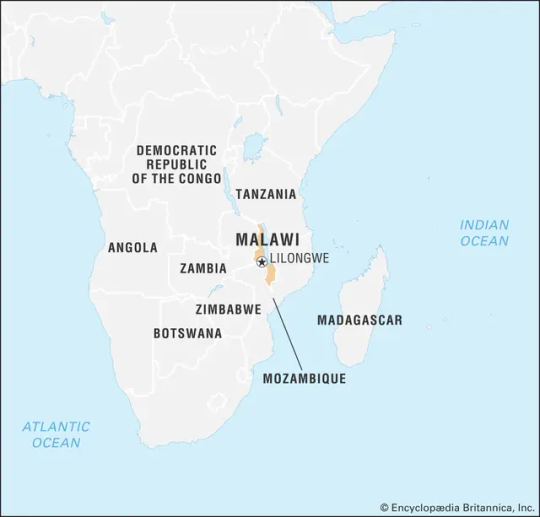
There are three main climates: dry-winter tropical savanna in the east and southwest and monsoon-influenced humid subtropical and monsoon-influenced subtropical highland in the southeast and west. Temperatures range from 9 °C (48.2 °F) in winter to 31 °C (87.8 °F) in summer. The average annual temperature is 21.9 °C (71.4 °F).

The country is divided into three regions, which are further divided into twenty-eight districts. The largest cities in Malawi are Lilongwe, Blantyre, Mzuzu, Zomba, and Karonga.

History
1480-1891: Kingdom of Maravi
1891-1907: British Central Africa Protectorate
1907-1964: Nyasaland Protectorate
1964: cabinet crisis
1964-present: Republic of Malawi
Economy
Malawi mainly imports from South Africa, China, and India and exports to Zimbabwe, Mozambique, and Belgium. Its top exports are tobacco, soybeans, and engine parts.
Its main agricultural products are cotton, sugar, tea, and tobacco. Services represent 56.1% of the GDP, followed by agriculture (29.4%) and industry (15.8%).

Malawi is a member of the African Union, the Common Market for Eastern and Southern Africa, the Commonwealth, and the Southern African Development Community.
Demographics
The Chewa people are the largest ethnic group (25.2%), followed by the Tumbuka (20.4%), Lomwe (17.9%), Yao (15.3%), Ngoni (5.4%), Sena (4.8%), and Mang’anja (3.2%). The main religion is Christianity, practiced by 82.3% of the population, 58.5% of which is Protestant.

It has a neutral net migration rate and a fertility rate of 3.4 children per woman. 18% of the population lives in urban areas. Life expectancy is 72.4 years and the median age is 16.8 years. The literacy rate is 62.1%.
Languages
The official language of the country is English, but the main languages are Chewa, Tumbuka, and Yao, spoken by 53.8%, 28.2%, and 16.1% of the population, respectively.
Culture
Malawians are esteemed for their kind and loving nature, and the country is known as the “warm heart of Africa”. There is a rich tradition of basketry and mark carving.
Men traditionally wear a short-sleeved shirt and pants. Women wear a blouse, a long skirt, and a headdress (duku).
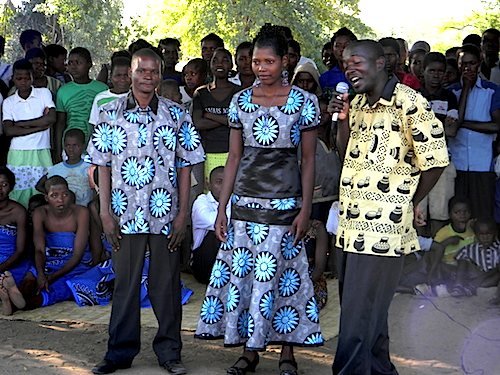
Architecture
Traditional houses in Malawi have mud bricks walls and thatched roofs.
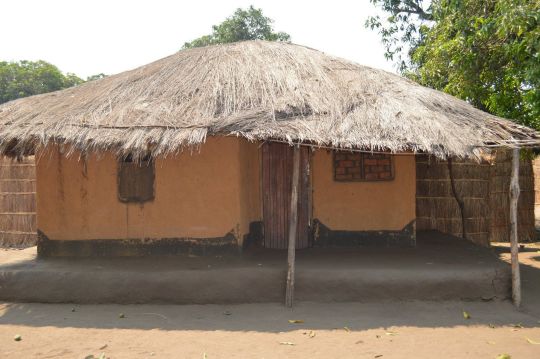
Cuisine
The Malawi diet is based on fish, meat, and vegetables. Typical dishes include chambo (a kind of fish served with nsima or rice), kondowole (fried cassava balls), mandazi (fried triangular donuts with powdered sugar), mkhwani (a stew of peanuts, pumpkin leaves, and tomatoes), and nsima (corn porridge eaten with fish or meat).
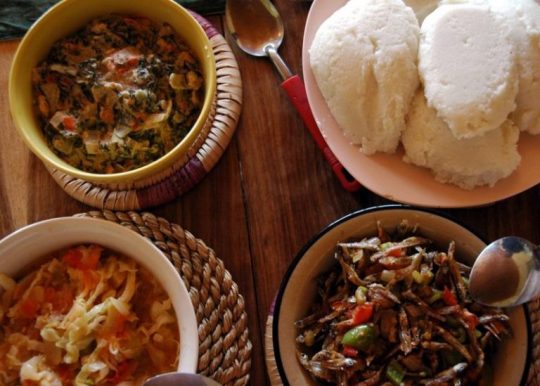
Holidays and festivals
Like other Christian and Muslim countries, Malawi celebrates Good Friday, Easter Monday, Christmas Day, Boxing Day, and Eid al-Fitr. It also commemorates New Year’s Day and Labor Day.
Specific Malawian holidays include John Chilembwe Day on January 15, Martyrs’ Day on March 3, President Kamuzu Banda’s Birthday on May 14, and Independence Day on July 6.
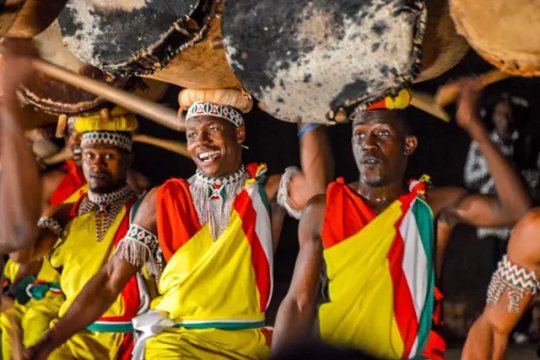
Independence Day
Other celebrations include Art in the Park, where artists exhibit their works; the Blantyre Arts Festival, which features dance, poetry, and theater, and the Lake of Stars Festival, a music festival.
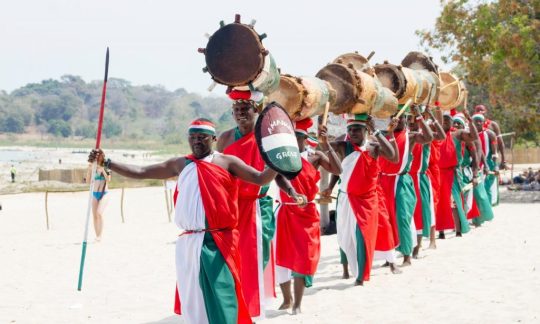
Lake of Stars Festival
Landmarks
There are two UNESCO World Heritage Sites: Chongoni Rock Art Area and Lake Malawi National Park.
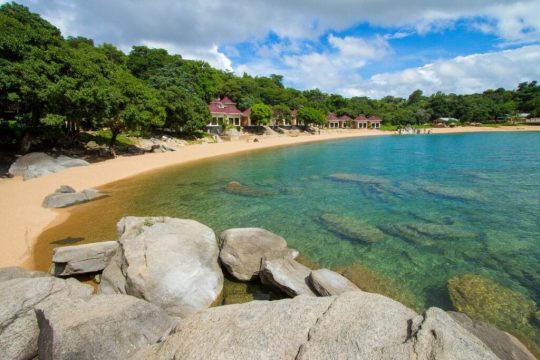
Lake Malawi National Park
Other landmarks include the King African Rifles Monument, the Nyika National Park, Saint Michael and All Angels Church, Saint Peter’s Cathedral, and the Vwaza Marsh Wildlife Reserve.
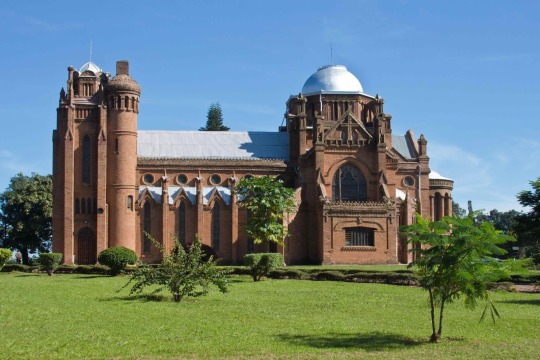
Saint Michael and All Angels Church
Famous people
Chakufwa Chihana - human rights activist
Emily Mkamanga - writer
Frank Chipasula - writer
Gertrude Webster Kamkwatira - actress and theater director
Isaac Chilemba - athlete
James Sangala - soccer player
Jane Chimaliro - netball player
Malia - singer
William Kamkwamba - inventor
Zahra Pinto - swimmer
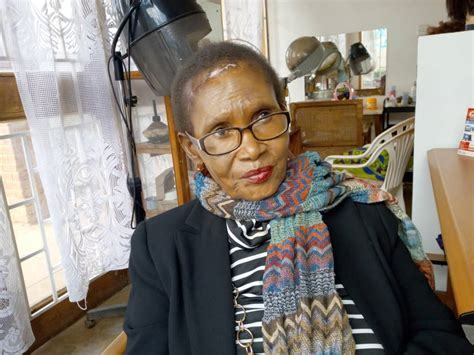
Emily Mkamanga
You can find out more about life in Malawi in this interview and this video.
7 notes
·
View notes
Text
Zimbabwe permaculture education center promotes self-sufficiency
German structure agency Studio Anna Heringer has accomplished the primary kindergarten in Zimbabwe’s Chimanimani District, a rural and desolate area house to about 200 households which have lengthy lacked entry to schooling. The kindergarten, which builds on the agency’s award-winning portfolio of humanitarian structure, serves as a pilot undertaking for PORET, Zimbabwe’s permaculture group, to advertise permaculture and encourage self-sufficiency in the area people. Utilizing group labor to help the native financial system, the buildings are constructed from regionally sourced timber, thatch and stone.
Proceed studying beneath
Our Featured Movies

Constructed over roughly 11 months in 2014, the kindergarten consists of a pair of domed buildings set on stone foundations. The structural frames use timber from Zimbabwe tree plantations. Impressed by the nation’s lovely thatched roofs and the routine custom of reducing grass to decrease an space’s threat of fireplace, the architects lined the structural ribs with thatching.

Native craftsmen had been employed for the labor-intensive work of thatching and constructing the stone foundations, thus offering the group with a very good share of the development price range. “With these native methods the undertaking goals to construct with a course of that reinforces solidarity and workforce spirit, expertise and data, self-confidence and dignity,” the architects defined. “Because of the contexts local weather and native circumstances buildings, except in-built glass and metal, is not going to final without end, however it’s important that the know-how to keep up and rebuild them is stored alive and traded on to the next generations. This is the reason we see this undertaking primarily as a coaching in superior constructing methods with present supplies that may grow to be the compost of the kindergarten fields someday.”

Thanks!
Maintain an eye fixed out for our weekly publication.
Be part of Our Publication
Obtain the newest in world information and designs constructing a greater future.
SIGN UP
SIGN UP
Related: Donkey-drawn mobile libraries bring books to people in Zimbabwe

Whereas in operation, the kindergarten will train kids permaculture ideas from the fundamentals of soil and plant care to water harvesting methods. The 2 buildings also can operate as coaching and assembly areas for the group.
+ Studio Anna Heringer
Pictures by Margarethe Holzer
Source link
source https://fikiss.net/zimbabwe-permaculture-education-center-promotes-self-sufficiency/ Zimbabwe permaculture education center promotes self-sufficiency published first on https://fikiss.net/ from Karin Gudino https://karingudino.blogspot.com/2021/03/zimbabwe-permaculture-education-center.html
0 notes
Text
Why does Black Panther look Like That? Trailer 1(Part One): Wakanda
I’m breaking down the Black Panther trailer(yet again I know), but this time focusing on it’s aesthetics and trying to point out the reasons behind some of the design elements, and the cultures that inspired them, in another super long, super detailed blog post. No, shush I am not obsessed okay just go with it.
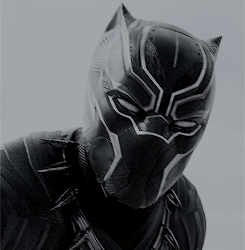
Looking through it(for the hundreth time) I realized that Black Panther has pulled from a vast number of cultures and communitites, so I may miss some, or get others wrong. The points below will be largely based on my own cultural experience(and meagre education on Traditional African Society) and some google :3. So this is like 60 percent speculation. Feel free to correct me. I also try to avoid spoilers below, but here’s a potential spoiler alert just in case.
With that out of the way, Enjoy!
Part One: Location; Let’s Talk About Wakanda
You can read about its history here but it’s basically a futuristic African country.
In the trailer we get this great overhead reveal of Wakanda. Note the shapes of the buildings, especially the roofs. Despite looking contemporary at first glance, they follow a similar design to grass thatched huts.
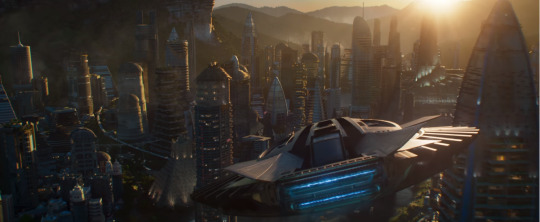
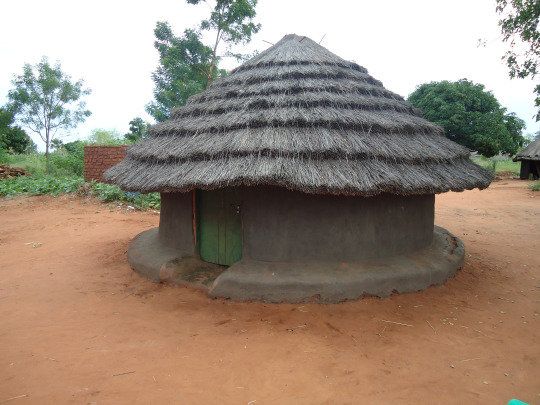
Next we have a shot of the people receiving their King as he returns from a journey.
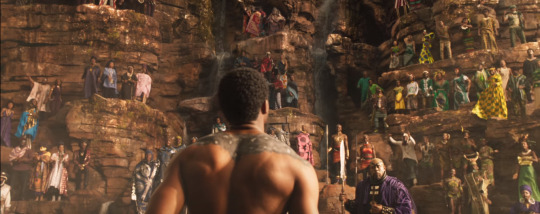
This Wakanda follows some African countries in that they are a people of different comunities or tribes with different ancestry,culture, customs, mannerisms or attire(or even languages) living together. Where I’m from we’re 47 tribes living in a country about the size of Colorado.
There is also the guy in purple in the middle ground of the photo. I’m guessing this is the King’s personal advisor or the royal witch doctor, or both(more on him below).
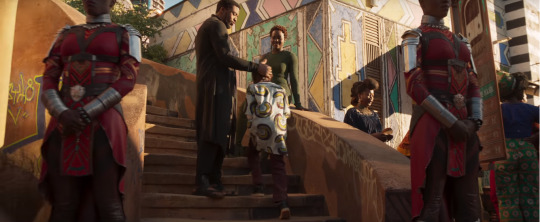
In this shot, it looks like T’challa is taking a stroll in some Wakandan town(I’m assuming because of the grafitti on the walls) with Lupita’s Nakia as the Dora Milaje(the royal guard) stand guard nearby. Note the building behind them is covered in art made up of colorful shapes. That is very similar to the architecture of the Ndebele located in South Africa, Zimbabwe and Botswana.

We also have a shot of the king’s throne room:
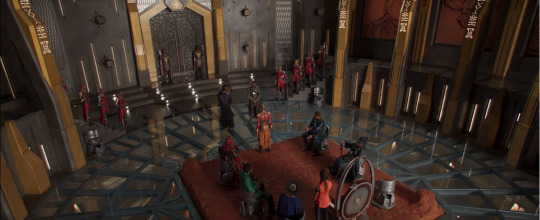
The Dora Milaje stand guard(along with two guards of Mr. Green?). It looks like the elders, or representatives of every tribe, are coming together to have a super important meeting. Maybe a trial? In traditional African society the chief would make the decisions but he would often be surrounded by a counsel of wizened elders who would advise or caution him. In some communities people who broke the rules would be brought to the elders who would decide the right punishment for them. They would also resolve conflicts among the people, and preside over special occasions like naming ceremonies, weddings, funerals among others. In some, there would be no chief, only a council of elders. Some communities still have councils to this day.
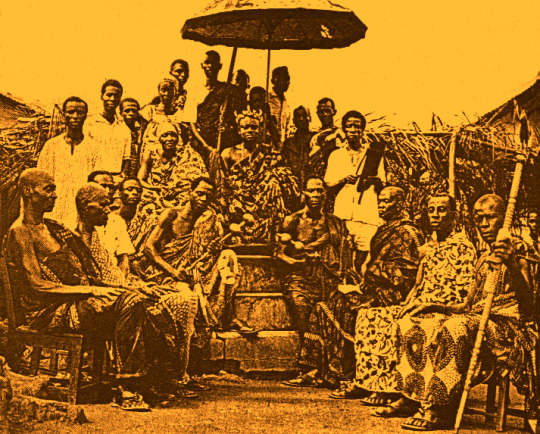
However, it could also be representatives of the different tribes or clans of Wakanda, meeting to discuss an issue that affects or will affect them all. This is not uncommon. Some tribes would be divided into different clans, if something important needed to be discussed, each would send a representative. They had to be well spoken and knowledgable in the rules of the community.
Note the colours chosen for the achitecture of the throne room. Instead of portraying materials like marble, they have stuck to earthy tones and gold(which may have been used to symbolize royalty).
Here we have Nakia, Queen Ramonda and Everett Ross at what looks like a shrine high up in a mountain:

I brightened it up a bit.
At first I thought it was a shrine, but it looks more like the base of operations, or home, of one of our antagonists(more on him under attire). It would also explain why they have fur in their attire, because the live high up on the snowy mountain peak. Some mountains like Kilimanjaro,(that one in the opening scene of the Lion King) are so high that they have snow at their peaks, despite being in tropical(hot all year) places. See the gif below for the Lion King scene...
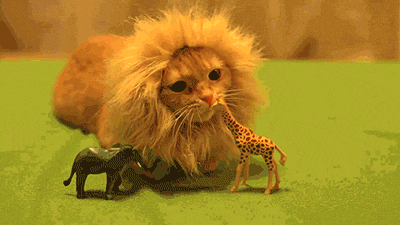
Just kidding here is the real one. And a photo of the real thing for comparison.
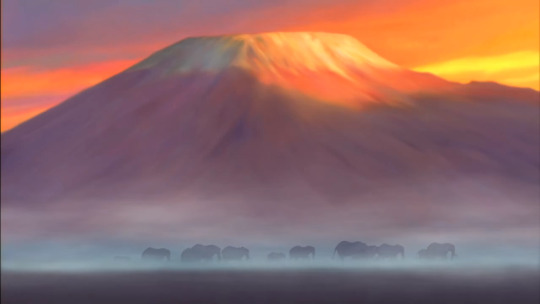

Moving on, in this shot we have some Wakandans performing what looks like a ritualistic task:
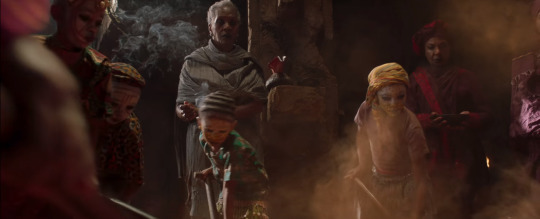
They could be making the herb that gives Black Panther his abilities, in preparation to ‘anoint’ the next Black Panther.
Many communities have had close relationships with nature. People could easily recognize which plants were food, medicine, poison, for toothbrushes or even toilet paper(yup). And in villages there was often a lineage(often that of the witchdoctor) specializing in herbalism. Today, industries have been built around providing herbal remedies. I assume that this herb is considered to be royal or even of divine nature.
I also think that this is happening right before or after the fight between Killmonger and T’Challa. I say this because the children of the community, who have been gathered and their faces painted in a distinct, almost ghostly style, similar to that of the face painting of the Surma of South Sudan and Ethiopia, are given the task of stirring something off screen.
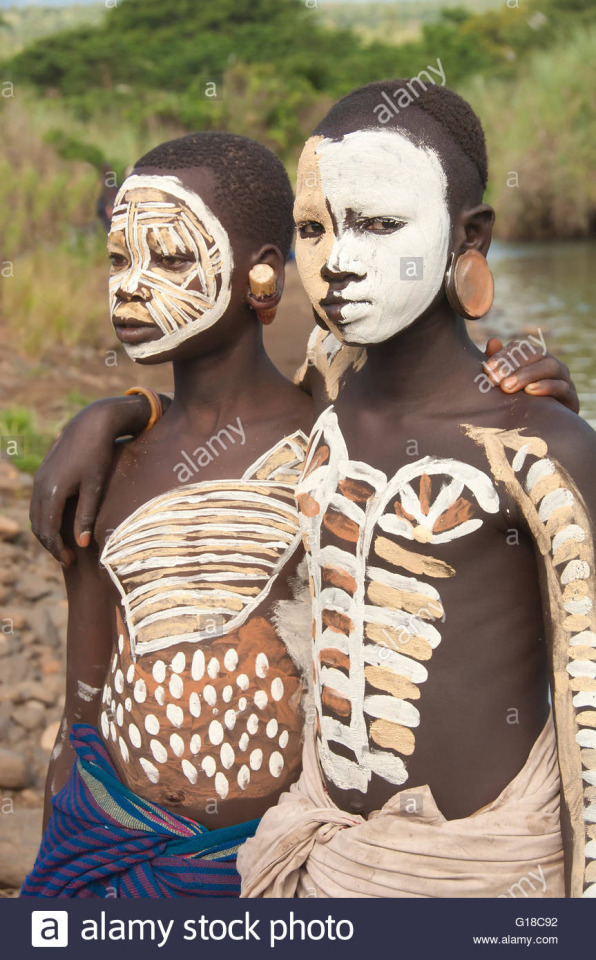
Only the children seem to be stirring away as the adults stand solemnly in the background. To me, it looks like this is an important, even sacred, ceremony for the community of Wakanda. If they were following traditional African culture and this was just casual cooking, it would be the women handling the food, with the children doing errands(and the men out on the farms or something).
Take note that our royal advisor/witchdoctor is present, possibly supervising.
Next we have a waterfall reminiscent of(but isn’t actually) the Victoria Falls in Zambia. If you go to the image here, you see that the Victoria falls look like a literal crack in the ground with water flowing into it, like the pic below.

There was also something similar in The Lion King.

And that’s it for now!
Thank you for making it this far in my long rambling rant. I like inspiring people to discuss so don’t feel shy to disagree or agree. If you love it, hate it, let me know!
I’m still working on Part 2 and 3, (ALAS I SAW THE LAST TRAILER TOO LATE. I’m posting this before I watch it) but I hope to finish the series before the actual movie. Once I have it ready I’ll link it here.
Thanks again! Here’s your potato.

6 notes
·
View notes
Text
The “Top Ten” of our South Africa Adventure
We are now reflecting back on our month-long trip as we get ready to head home. It has been a truly memorable experience from start to finish. Most of our time was spent in South Africa, but we managed to get a little flavour of life in neighbouring countries of Zimbabwe, Botswana and e-Swatini (Swaziland) as well. We had an excellent, knowledgeable Gate 1 tour director, met some interesting people along the way and had so many wonderful experiences. Remarkable encounters that will stay in our memory banks forever.

We settled on our top ten “best of” list. Here goes…
1. Experiencing African wildlife up close and personal: a herd of elephants traipsing by our jeep in silence, a lone giraffe munching on eucalyptus, two zebras staring back at me, baboons doing naughty things....
2. Victoria Falls for its cascades, historical significance (”Dr Livingstone, I presume?”), stunning rainforests and quirky little town.
3. Local cuisine par excellence: We loved the South African specialities such as ostrich, eland, kingklip, pap, rooibus tea, bobotie, biltong, bunny chow, chutney, malva pudding, and the Cape Malay curries – plus, a great cucumber gin and tonic too!
4. Community marketplaces of arts and crafts: such an impressive kaleidoscope of colours and products: batik, candles, wood carvings, beaded jewelry, hats, wraps, recycled plastics...
5. The contrast in landscapes, ranging from sub-tropical jungle to towering Drakensburg Mountains, from the raging Indian Ocean coastline to the Karoo outback and dusty fynbos of Western Cape. Awesome!

6. Cape Town for its azure coastline, cablecar up to Table Mountain and its cosmopolitan flair.
7. Overnight in a safari bush lodge: an 'out of Africa' experience with thatch-roof bungalows, lush gardens of agapanthus and banana trees, and zebras, kudu and impalas grazing right outside our front door.
8. Old French Huguenot town of Franschhoek with stunning mountain backdrop, Cape Dutch architecture and a wonderful selection of wines.
9. Seeing South Africa as an agricultural powerhouse: Broad expanses of fields stretching into the horizon growing everything from to fruit (apples, mango, avocado, grapes) and vegetables (eggplant, pumpkin, tomatoes), grains, beef, ostrich, sheep, you name it…
10. Resilience and spirit of South African people from the dark past of apartheid to today's freedom and robust melting-pot of cultures. As Nelson Mandela declared, “no power on earth can destroy the thirst for human dignity.” Their story is humbling, their smiles heart-warming.

0 notes
Photo

Why white Zimbabwean farmer, Ben Freeth, returned to his farm eight years after it was destroyed by pro-Mugabe forces
Stripped of their land and forced to watch their house torched, Kent-born Ben Freeth and his family have seen first-hand the violence and unpredictability of Zimbabwe’s authoritarian regime. Yet after beatings, torture and court battles, he still has hope for the hundreds of thousands of farmers and farmworkers who have lost their livelihoods to Robert Mugabe.
There is just birdsong now, birdsong and the sound of the breeze rustling the long, dry grass that surrounds Ben Freeth’s ruined home. ‘It’s a little haven of peace,’ the British-born farmer remarks wryly as he surveys the remains of the house that he and his wife, Laura, built with their own hands, of local materials, on the fertile plain of central Zimbabwe in 1997.
The Freeth House in December 2000 Credit: Courtesy of Ben Freeth
This is where they raised their three children until Robert Mugabe’s ‘war vets’ arrived eight years ago to sow not crops, but terror. Only the walls still stand. Where once there were windows there are now gaping holes. Bushes grow in the debris that covers the floors. The wiring was stripped out long ago.
Terror Takes Hold
‘That was the kitchen. This was the dining room, and over there the sitting room,’ Freeth says. Poignant reminders of happier days lie on the piles of bricks and fallen plaster – a bit of piano frame, broken flower pots, a rusted bread bin, sofa springs, a fridge door. Outside, dead leaves rot in the bottom of the empty swimming pool.
Except for the brick paths, nature long ago reclaimed Laura’s English flower garden. ‘It’s amazing how quickly man’s efforts can be annihilated,’ Freeth observes. Beyond the pool is a mound of earth on which a gazebo used to stand. ‘I remember sitting here, and nine giraffes wandered right past us. That was in 2008 or early 2009, and the last time I ever saw them. Now there’s not an animal left,’ he says.
From that same mound Freeth and his family watched, appalled, as their home burnt down at midday on August 30, 2009. They returned from church to find the war vets had set a fire beside some farmworkers’ houses barely 100 yards away.
In August 2009, the house was burnt down Credit: Courtesy of Ben Freeth
There was a strong wind. The vegetation was tinder-dry. In no time the sparks set the thatched roof of their own house alight. Freeth managed to grab the safe, his computers and a camera, but that was all. ‘Within minutes the whole thing was ablaze. You couldn’t go anywhere near it. It was an inferno.’
As the house burnt, the war vets drove by on a stolen tractor with a 2,000-litre spray tank on the back. Instead of using it to extinguish the fire, they laughed. The family dog, Topsy, and cat, Brown, died in the fire. Three days later those same thugs burnt down the nearby home of Laura’s parents, Mike and Angela Campbell.
The family’s long, courageous fight to keep their property – the most productive mango farm in Zimbabwe – was over. After years of being harassed, terrorised, abducted and beaten, they had finally been ‘jambanja-ed’ – forcibly evicted.
They had paid the price for daring to take Mugabe to the highest court in southern Africa, and winning
They had paid the price for daring to take Mugabe to the highest court in southern Africa and winning; for being white in the land of a black despot who would rather see his people starve than lose his grip on power. ‘It’s horrific to see your home in ruins simply because you have the wrong coloured skin,’ Freeth says. ‘That, ultimately, was our crime.’
Tall and moustachioed, Freeth was born in Sittingbourne, Kent, in 1969. When he was 12, his father moved to Zimbabwe to set up a staff college for its new, post-independence army. Freeth fell in love with the country. He returned there after a year at the Royal Agricultural College in Cirencester, and in 1994 married Laura on her parents’ 6,000-acre farm, Mount Carmel.
The Freeths’ sitting room before it was destroyed Credit: Courtesy of Ben Freeth
He shows me the wedding site – a ring of rocks in a small wildlife reserve overlooking a dam on the Biri river built by his father-in-law. The altar was made from old railway sleepers. Guests sat on hay bales. A friend played a piano on the back of a truck. ‘It was a very happy day,’ says Freeth.
Today the dam leaks, the Biri River Safari Lodge is an empty shell, and the reserve’s giraffes and impala, zebras and warthogs, eland and kudu are long gone – killed and eaten by war vets. Mike Campbell created the reserve. He loved the animals. In the last years of his life, he could not bear even to watch wildlife programmes on television. ‘It was too painful,’ says Freeth.
Civil Unrest
Freeth was employed by the Commercial Farmers Union, and witnessed the growth of Zimbabwean agriculture in the 1990s. ‘Everyone was developing and building dams. They had diversified into everything under the sun. It was extraordinary what people could grow in this country and export to Europe. It was an era of huge successes and we were probably the fastest-growing economy in Africa.’
Ben Freeth, with Peter Asani (left) and Sinos Bois (right), who worked for him on the farm, inspects graffiti on the ruins Credit: Courtesy of Ben Freeth
But in 2000 some white farmers made the mistake of backing the newly formed opposition Movement for Democratic Change (MDC). Mugabe retaliated by unleashing veterans of the 1970s war of independence to punish the farmers and destroy a potential reservoir of MDC support among the country’s million black farmworkers and their families.
Across the country, mobs loyal to Mugabe’s ruling Zanu-PF party invaded farms. Drunk or high on mbanje (cannabis), armed with axes, machetes and pangas (long knives), they attacked, terrorised and occasionally killed the farmers, their families and their workers.
Drunk or high on mbanje (cannabis), armed with axes, machetes and pangas (long knives), they attacked, terrorised and occasionally killed farmers
They slaughtered cattle and pets, stole tractors and combine harvesters, destroyed crops, cut down trees and held all-night pungwes – indoctrination sessions with non-stop drumming and chanting around bonfires on the farmers’ lawns. They frequently gave those farmers just hours to leave their properties, then ransacked their homes.
The police stood by and the courts did little, which was hardly surprising as at least 16 senior judges were on the long list of Zanu-PF cronies – ministers, MPs, army commanders, district administrators, councillors, girlfriends – who received farms in the name of a land- redistribution programme supposed to help the indigenous poor.
Ben Freeth outside his ruined home in November 2016 Credit: LFrewin
Robert and Grace Mugabe acquired 13 farms. All Zanu-PFs 56 politburo members, all 10 provincial governors and 98 MPs acquired at least one. The first vets arrived at Mount Carmel in late-2000, moved into a hay shed and began a relentless campaign of harassment and intimidation. They also brought with them a virulent strain of malaria, which killed 11 workers and Freeth’s sister-in-law, Heidi, who was pregnant with twins.
‘If the land invasions hadn’t happened she wouldn’t have died,’ says Freeth as he shows me her grave in the overgrown grounds of his in-laws’ former house. Of the beautiful garden only a rampant bougainvillea remains. In 2004, Nathan Shamuyarira, a former cabinet minister, claimed Mount Carmel. The next year, Zanu-PF amended the constitution to allow the government to seize land without offering recourse or compensation, and in 2006 it introduced two-year prison sentences for farmers who resisted.
The Quest for Justice
In 2007, Campbell and Freeth sued Mugabe before the Southern African Development Community (SADC) Tribunal. It was an astonishingly bold step. ‘The definition of appeasement is feeding the crocodile and hoping you’ll be the last to be eaten,’ Freeth explains.
‘There were many times when we thought, “Why are we battling it out?” But at the back of our minds we were saying, “How dare these people get away with all these things, and what’s going to happen if we do leave? Our farmworkers will be destitute and everything we’ve built up will be destroyed.”’
Ben at his sister-in-law Heidi’s grave, in the garden of his parents-in-law’s home Credit: Courtesy of Ben Freeth
On June 29, 2008, a fortnight before their case was due to be heard, Freeth and the ageing Mike and Angela Campbell were seized by war vets, trussed up, severely beaten with sticks and rifle butts, and driven into the bush, where their torture continued late into the night.
Their abductors beat the bottom of Freeth’s feet with sjamboks – whips made of hippopotamus hide. They put a burning stick into Angela Campbell’s mouth, and forced her to sign – at gunpoint – a statement promising to drop the SADC case.
At midnight, Freeth and the Campbells were dumped on a roadside, barely conscious. All three had broken bones and faces bruised almost beyond recognition. Freeth suffered a fractured skull, but attended the SADC hearing in Windhoek, Namibia, in a wheelchair with his head heavily bandaged.
Ben after his beating at the hands of Zimbabwean war vets Credit: WorldPictureNetwork
That November, the tribunal ruled that they should be allowed to live and work peacefully on their farm. It was a moment of extreme euphoria. ‘We were incredibly excited,’ Freeth recalls. ‘Here were black African judges ruling for the first time that white people have a place in Africa.’ The plaintiffs and their lawyers hugged tearfully in the courtroom.
But the celebrations proved premature. Mugabe called the ruling a ‘nonsense’. He declared, ‘Our land issues are not subject to the SADC Tribunal.’ A new group of armed war vets led by Lovemore Madangonda, alias Landmine, arrived at Mount Carmel to ratchet up the terror.
They threatened to kill Freeth’s children. They wrapped barbed wire around a horse’s head and mouth. ‘It was continual harassment – stealing cattle, poaching game, cutting down trees, getting in your face all the time,’ says Freeth.
Finally, they burnt down the Campbells’ and Freeths’ homes. The family lost almost everything save, miraculously, a tattered black and white photograph of Angela as a very young girl that had sustained her father when he was a prisoner of war in Germany in the Second World War. He called it his ‘lucky charm’.
Laura in the ruins of the Freeth house Credit: Courtesy of Ben Freeth
Mike Campbell never really recovered from his injuries. ‘His spirit to fight for justice carried on, but his will to live became difficult,’ Freeth says. He died in 2011. He was buried on a neighbouring farm that was still white-owned, and hundreds of mourners, including many of his old farmworkers, attended his funeral.
Those Left Behind
The Freeths moved to Harare. In 2010, the British government pointedly awarded Freeth an MBE for services to farming. Today, he and Laura’s brother, Bruce, farm 40 hectares of rented land while Laura runs a small cake business.
‘It’s hard to get by,’ Freeth admits, quickly adding, ‘But we are much better off than our farmworkers.’ Mugabe’s land seizures did not just destroy the Freeths’ livelihood. They destroyed that of their 500 workers and dependents, of the region and of the entire country.
Today they are hungry, emaciated and jobless. They have no electricity, and walk two miles for water.
Peter Asani, 69, Freeth’s old foreman, and Sinos Bois, 58, who helped run the farm’s irrigation system, meet us in the ruins of Freeth’s house – loyal retainers who were beaten by war vets for supporting their mabhunus (white farmers). You can still feel the lump where Bois’s skull was fractured by a steel bar.
Before the land invasions, both men earned a decent salary. They received food and housing. Their children attended school. A mobile health clinic visited twice a week. Laura ran a small embroidery business, which gave the farmworkers’ wives an income.
Today they are hungry, emaciated and jobless. They have no electricity, and walk two miles for water. They survive on sadza – a maize porridge. If they and their families eat just once a day they can make a $6 bucketful last five days.
Farm machinery was destroyed Credit: LFrewin
Asani receives a tiny state pension, Bois nothing – ‘Not two dollars, not one dollar, nothing.’ Nothing to pay his grandchildren’s school fees of $15 a term. Nothing to buy seeds, though the rains have come and it is planting season.
As opponents of Zanu-PF, they receive no government food aid. ‘It was a good life, but we’re starving now,’ Asani says, though he lives in the middle of rich land. We drive across the farm. Freeth watches nervously for war vets, but the land is desolate and abandoned.
Where maize and sunflowers grew in abundance, scrubby thorn bushes have taken root. Fences have been torn down. Irrigation pipes are broken. The boreholes are disused. The tractors and other farm machinery disappeared long ago.
Many of the 40,000 trees in the mango and citrus orchards are dead or dying for lack of water. Some have been burnt because nobody extinguishes dry-season fires.
The homes of Mount Carmel farmworkers were also destroyed by fire in August 2009 Credit: Courtesy of Ben Freeth
Mount Carmel used to produce 1,200 tons of mangoes and oranges a year. Today it produces nothing. Another former farmworker appears. Friday leans on a bicycle with no pedals because he has a prosthetic leg. Freeth explains that war vets sent him to fetch wood one night, and his tractor hit a school bus. Friday is carrying a catapult. He is looking for birds, he says. He needs food.
Near the old safari lodge a few squatters have commandeered small plots of land. They show no hostility. They too are desperate. ‘We’re growing maize but it’s no good,’ says Tawanda Mapepa, 21. From six hectares he coaxed just 12 bags in 2016 – a 60th of what Campbell would have produced on the same area.
Near the old safari lodge a few squatters have commandeered small plots of land. They show no hostility. They too are desperate.
He complains that the government has provided no fertiliser or seeds for the coming season. Oblivious to the irony, he begs Freeth for help. Mount Carmel is no exception. Of the 30 other farms in the district, just one still has white owners.
Across the country, barely 300 of 4,500 white farmers survive, mostly because they have collaborated or paid protection money, or been overlooked because they are remote.
The result is catastrophic. Maize production has fallen from two million tons in 2000 to 500,000 in 2016, wheat from 250,000 to 60,000 tons. The number of cattle killed for beef has fallen from 605,000 to 244,000.
Mugabe’s Crippling Legacy
Zimbabwe once fed much of southern Africa, but today a third of its roughly 13 million people urgently need food aid. Freeth drives me to the nearby town of Chegutu, which is dominated by 12 towering silos. Each can hold 5,000 tons of grain, but an employee says just one is full, though the harvest has recently ended.
Workers are unloading a goods train bearing maize from Mozambique. ‘This used to be the grain basket of southern Africa, and here we are importing maize to prevent us from starving,’ Freeth exclaims.
We visit Bain Farm Equipment, an agricultural supplier. ‘This would be full of new tractors, ploughs, harvesters and people. It would be a hive of activity at this time of year,’ Freeth says as we park on its forecourt. Now there are three bored employees, the last survivors of a 20-strong workforce.
The President of Zimbabwe, Robert Mugabe Credit: Getty Images
They have sold one tractor all year, and have two ox-drawn ploughs on display. ‘The new farmers don’t buy anything. They don’t have the money,’ says one. Outside Chegutu we stop at the David Whitehead Textiles factory. It once employed 4,000 people, turning locally grown cotton into fabric, but closed in 2012.
Today a few gaunt men guard the premises. They are paid four loaves of bread a day, and pass the time playing draughts with bottle tops on cardboard. They turn up in the forlorn hope that they will be first in the queue for jobs should the factory ever reopen. ‘If I don’t do this, what else will I do?’ says one.
The farm seizures did not only destroy Zimbabwe’s agricultural sector. They destroyed the many industries that relied on it. They destroyed the nation’s entire economy
The farm seizures did not only destroy Zimbabwe’s agricultural sector. They destroyed the many industries that relied on it. They destroyed the nation’s entire economy, leading to hyperinflation, empty shelves and ever greater repression by a regime desperate to retain power. Freeth does what he can to help.
Through the Mike Campbell Foundation, he teaches former farmworkers to grow their own food, supports other dispossessed farmers and documents land seizures, which continue to this day.
To the Future
But mostly he waits. He waits for Mugabe, now 92 and visibly deteriorating, to die. He waits for the day when property rights and the rule of law are restored. Having been held in contempt of court three times, the regime managed to have the SADC Tribunal disbanded in 2012, but its ruling still stands.
‘Mugabe can’t last for ever,’ says Freeth. ‘The time may come when we have a government that says, “We want people to be employed, producing food, and economic activity to start coming into the country.” The time may come when they come to us and say, “We need to get this farm up and running again.” We will sit tight and wait and do what we can in our own little way.’
Back in Harare, Freeth and I drive to a handsome villa set in large, walled grounds. This is the house of Nathan Shamuyarira, the former cabinet minister who claimed the farm.
He died in 2014, but his widow, Dorothy, is still alive, and Freeth wants to try to meet her. To our surprise, a gardener opens the steel gate without asking who we are.
Watch | Anti-Mugabe protesters clash with police in Zimbabwe
00:44
A maid admits us when we knock on the front door, and there she is – an elderly, well-fed woman in a wheelchair who visibly starts when Freeth introduces himself. She knows full well who he is, but cannot escape. Freeth, a devout Christian, asks how she is.
He commiserates on her husband’s death. Then he gently explains how the farm is abandoned, the orchards are dying, the people starving.
He invokes commandments – ‘You shall not steal,’ and, ‘You shall not covet your neighbour’s house.’ He asks if she would consider letting someone else farm the land. Dorothy Shamuyarira looks acutely uncomfortable. She fidgets, staring out of the window at her well-tended garden.
‘It was an opportunity for her to show some little bit of remorse for the destruction that’s taken place and the lives that have been ruined, but there was none’
Though physically disabled, she is mentally sharp. At first she insists she has plans for the farm, and tells Freeth he was wrong to seek legal redress, but then she clams up. ‘You will have to ask the government,’ she replies to Freeth’s questions.
I ask if she feels any regret at what happened. ‘I’m not going to comment,’ she says. After 30 minutes, we leave. ‘God bless you,’ Freeth tells Shamuyarira with a magnanimity he does not really feel.
‘It was an opportunity for her to show some little bit of remorse for the destruction that’s taken place and the lives that have been ruined, but there was none,’ he says as we drive away. ‘Why did they take the farm? Its not for any material benefit for themselves, the community or society. They took it as a child takes another child’s toy and throws it in the bin.’
Martin Fletcher’s visit to Zimbabwe was financed by the Pulitzer Center on Crisis Reporting
http://zimbabwe-consolidated-news.com/2017/01/07/why-white-zimbabwean-farmer-ben-freeth-returned-to-his-farm-eight-years-after-it-was-destroyed-by-pro-mugabe-forces/
0 notes
Text
Framework thatchers the best thatching company in Harare Zimbabwe
Framework Thatchers Zimbabwe is the best thatching companies in Zimbabwe. Offering thatching services in Harare Zimbabwe. We are experts in the wood pole installation on roof and from ground. Our services are available for structures that include houses, gazebos, rural huts, church, venues, holiday resorts, bar, chalets, lodges, sheds, kitchens, lodges and more. We also do rethatches and repairs…

View On WordPress
0 notes
Text
Discovering the world
Botswana 🇧🇼
Basic facts
Official name: Republic of Botswana
Capital city: Gaborone
Population: 2.4 million (2023)
Demonym: Batswana
Type of government: unitary parliamentary republic
Head of state and government: Mokgweetsi Masisi (President)
Gross domestic product (purchasing power parity): $54.64 billion (2024)
Gini coefficient of wealth inequality: 45.5% (medium) (2016)
Human Development Index: 0.708 (high) (2022)
Currency: pula (BWP)
Fun fact: It has Africa’s largest population of elephants.
Etymology
The country’s name means “land of the Tswana”.
Geography
Botswana is located in Southern Africa and borders Zambia to the north, Zimbabwe to the northeast, South Africa to the south, and Namibia to the west and north.

There are two climates: hot steppe in the north and southeast and hot desert in the center and southwest. Temperatures range from 4 °C (39.2 °F) in winter to 32 °C (89.6 °F) in summer. The average annual temperature is 20.9 °C (69.6 °F).

The country is divided into ten administrative districts, two cities, and five towns. The former are further divided into twenty-three subdistricts. The largest cities in Botswana are Gaborone, Francistown, Mogoditshane, Maun, and Molepolole.

History
200: arrival of Bantu people
400: arrival of Tswana people
1075-1220: Kingdom of Mapungubwe
1450-1683: Kingdom of Butua
1810s-1840s: Mfecane
1816: arrival of first Europeans
1885-1966: Bechuanaland Protectorate
1966-present: Republic of Botswana
Economy
Botswana mainly imports from South Africa, Namibia, and Canada and exports to India, Belgium, and the United Arab Emirates. Its top exports are diamonds, beef, and copper.
The economy is based on mining and tourism. Services represent 70.6% of the GDP, followed by industry (27.5%) and agriculture (1.8%).

Botswana is a member of the Commonwealth and the Southern African Development Community.
Demographics
Tswana people represent 79% of the population, followed by Kalanga people (11%), white people (7%), and San people (2%). The main religion is Christianity, practiced by 79.1% of the population, 66% of which is Protestant.
It has a positive net migration rate and a fertility rate of 2.3 children per woman. 72.2% of the population lives in urban areas. Life expectancy is 65.6 years and the median age is 25.7 years. The literacy rate is 88.5%.
Languages
The official language of the country is English, which is spoken natively by 2.8% of the population, but Tswana is the national language and is spoken by 73.3% of the inhabitants. Other commonly spoken languages include Kalanga (17.2%) and Kgalagadi (2.4%).
Culture
People in Botswana value the community above individuals and believe in working together. It is common to address unknown people using the words for “father” and “mother”.
Men traditionally wear a piece of cloth made of animal skin around the waist (tshega), a blanket (kaross), and sandals. Women wear a wide skirt (mosese), an apron (khiba), a kaross, sandals, and a headwrap (tukwi).

Architecture
Traditional houses in Botswana are round, made of mud and wood, and have thatched roofs and a courtyard.

Cuisine
The Batswana diet is based on corn, meat, and vegetables. Typical dishes include bogobe (polenta made from corn and served with green vegetables), dikgobe (a dish of beans, corn, and lamb), melktert (a sweet pastry crust with custard filling), seswaa (beef or goat cuts served with ground corn or sorghum), and vetkoek (deep-fried ground meat).

Holidays and festivals
Like other Christian countries, Botswana celebrates Good Friday, Easter Monday, Ascension Day, Christmas Day, and Boxing Day. It also commemorates New Year’s Day (January 1 and 2) and Labor Day. Specific Batswana holidays include Sir Seretse Khama Day on July 1, which celebrates the birth of the first president; Presidents’ Day on the third Monday of July, and Botswana Day on September 30 and October 1).

Botswana Day
Other celebrations include Dithubaruba Cultural Festival, which features arts, dance, and music; Khawa Dune Challenge, which involves camping and dune racing, and Kuru Dance Festival, in which different ethnic groups showcase their costumes and dance styles.

Kuru Dance Festival
Landmarks
There are two UNESCO World Heritage Sites: Okavango Delta and Tsodilo, a set of caves with rock art.

Tsodilo
Other landmarks include the Central Kalahari Game Reserve, Chobe National Park, the Domboshaba ruins, the Gcwihaba Caves, and the Three Dikgosi Monument.

Three Dikgosi Monument
Famous people
Ernest Amos - soccer player
Frank Lesokwane - singer
Lebogang Manson - entrepreneur
Malia Baker - actress
Mpule Kwelagobe - model
Nijel Amos - athlete
Sasa Klaas - singer
Shona Ferguson - actor
Thato Sikwane - DJ
Unity Dow - judge and writer

Unity Dow
You can find out more about life in Botswana in this article and this video.
8 notes
·
View notes
Text
Framework Thatchers Zimbabwe is the best thatching company in Zimbabwe. We specialize in roofing and thatching houses, Gazebos, Charlets, rural huts and roundvales in Harare Zimbabwe. For more call or Whatsapp 0773974777 or 0772389998.
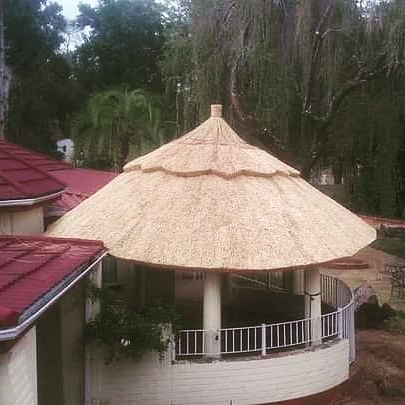
1 note
·
View note